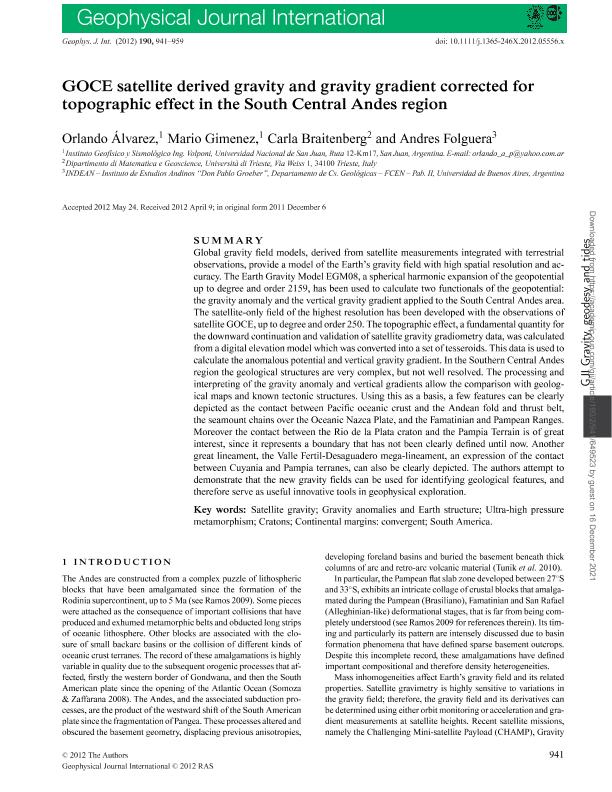Mostrar el registro sencillo del ítem
dc.contributor.author
Alvarez Pontoriero, Orlando

dc.contributor.author
Gimenez, Mario Ernesto

dc.contributor.author
Braitenberg, Carla

dc.contributor.author
Folguera Telichevsky, Andres

dc.date.available
2019-01-23T20:52:59Z
dc.date.issued
2012-08
dc.identifier.citation
Alvarez Pontoriero, Orlando; Gimenez, Mario Ernesto; Braitenberg, Carla; Folguera Telichevsky, Andres; GOCE satellite derived gravity and gravity gradient corrected for topographic effect in the South Central Andes region; Wiley Blackwell Publishing, Inc; Geophysical Journal International; 190; 2; 8-2012; 941-959
dc.identifier.issn
0956-540X
dc.identifier.uri
http://hdl.handle.net/11336/68486
dc.description.abstract
Global gravity field models, derived from satellite measurements integrated with terrestrial observations, provide a model of the Earth's gravity field with high spatial resolution and accuracy. The Earth Gravity Model EGM08, a spherical harmonic expansion of the geopotential up to degree and order 2159, has been used to calculate two functionals of the geopotential: the gravity anomaly and the vertical gravity gradient applied to the South Central Andes area. The satellite-only field of the highest resolution has been developed with the observations of satellite GOCE, up to degree and order 250. The topographic effect, a fundamental quantity for the downward continuation and validation of satellite gravity gradiometry data, was calculated from a digital elevation model which was converted into a set of tesseroids. This data is used to calculate the anomalous potential and vertical gravity gradient. In the Southern Central Andes region the geological structures are very complex, but not well resolved. The processing and interpreting of the gravity anomaly and vertical gradients allow the comparison with geological maps and known tectonic structures. Using this as a basis, a few features can be clearly depicted as the contact between Pacific oceanic crust and the Andean fold and thrust belt, the seamount chains over the Oceanic Nazca Plate, and the Famatinian and Pampean Ranges. Moreover the contact between the Rio de la Plata craton and the Pampia Terrain is of great interest, since it represents a boundary that has not been clearly defined until now. Another great lineament, the Valle Fertil-Desaguadero mega-lineament, an expression of the contact between Cuyania and Pampia terranes, can also be clearly depicted. The authors attempt to demonstrate that the new gravity fields can be used for identifying geological features, and therefore serve as useful innovative tools in geophysical exploration.
dc.format
application/pdf
dc.language.iso
eng
dc.publisher
Wiley Blackwell Publishing, Inc

dc.rights
info:eu-repo/semantics/openAccess
dc.rights.uri
https://creativecommons.org/licenses/by-nc-sa/2.5/ar/
dc.subject
Continental Margins: Convergent
dc.subject
Cratons
dc.subject
Gravity Anomalies And Earth Structure
dc.subject
Satellite Gravity
dc.subject
South America
dc.subject
Ultra-High Pressure Metamorphism
dc.subject.classification
Geoquímica y Geofísica

dc.subject.classification
Ciencias de la Tierra y relacionadas con el Medio Ambiente

dc.subject.classification
CIENCIAS NATURALES Y EXACTAS

dc.title
GOCE satellite derived gravity and gravity gradient corrected for topographic effect in the South Central Andes region
dc.type
info:eu-repo/semantics/article
dc.type
info:ar-repo/semantics/artículo
dc.type
info:eu-repo/semantics/publishedVersion
dc.date.updated
2019-01-23T17:06:35Z
dc.journal.volume
190
dc.journal.number
2
dc.journal.pagination
941-959
dc.journal.pais
Reino Unido

dc.journal.ciudad
Londres
dc.description.fil
Fil: Alvarez Pontoriero, Orlando. Universidad Nacional de San Juan. Facultad de Ciencias Exactas, Físicas y Naturales. Instituto Geofísico Sismológico Volponi; Argentina. Consejo Nacional de Investigaciones Científicas y Técnicas; Argentina
dc.description.fil
Fil: Gimenez, Mario Ernesto. Universidad Nacional de San Juan. Facultad de Ciencias Exactas, Físicas y Naturales. Instituto Geofísico Sismológico Volponi; Argentina. Consejo Nacional de Investigaciones Científicas y Técnicas; Argentina
dc.description.fil
Fil: Braitenberg, Carla. Universidad Nacional de San Juan. Facultad de Ciencias Exactas, Físicas y Naturales. Instituto Geofísico Sismológico Volponi; Argentina
dc.description.fil
Fil: Folguera Telichevsky, Andres. Consejo Nacional de Investigaciones Científicas y Técnicas. Oficina de Coordinación Administrativa Ciudad Universitaria. Instituto de Estudios Andinos "Don Pablo Groeber". Universidad de Buenos Aires. Facultad de Ciencias Exactas y Naturales. Instituto de Estudios Andinos "Don Pablo Groeber"; Argentina
dc.journal.title
Geophysical Journal International

dc.relation.alternativeid
info:eu-repo/semantics/altIdentifier/doi/http://dx.doi.org/10.1111/j.1365-246X.2012.05556.x
dc.relation.alternativeid
info:eu-repo/semantics/altIdentifier/url/https://academic.oup.com/gji/article/190/2/941/649523
Archivos asociados
